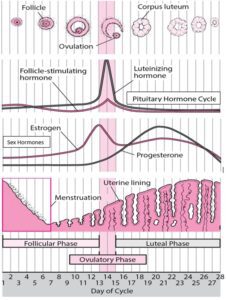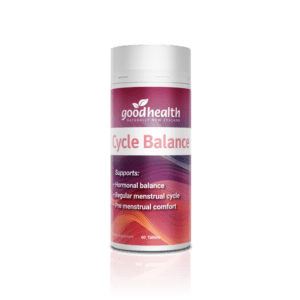
Để vinh danh sự ra mắt của Dòng sản phẩm Sức khỏe Phụ nữ, nhóm bác sĩ y học tự nhiên Good Health đã biên soạn một loạt bài viết về sức khỏe đi sâu vào thế giới phức tạp, tuyệt vời của 3 giai đoạn M—menarche, menstrual và chronic. Chúng tôi cũng sẽ khám phá vòng đời nội tiết tố và hệ vi sinh vật của phụ nữ, các vấn đề tiềm ẩn có thể phát sinh, những gì xảy ra và ở đâu, và một số lời khuyên của tổ tiên về cách hỗ trợ những gì là đặc trưng của phụ nữ.
Phần 2 – Kinh nguyệt
Thật khó để vượt qua thực tế rằng ở phần lớn các xã hội, kinh nguyệt được coi là một chủ đề cấm kỵ, với phụ nữ bị coi là bẩn thỉu hoặc thậm chí nguy hiểm vì điều đó. Niềm tin nguyên thủy bao gồm từ lo lắng về sự lây lan của vi khuẩn đến lo lắng rằng mùi máu sẽ cản trở việc săn bắt động vật. Các nền văn hóa truyền thống đối xử tôn trọng với phụ nữ trong thời gian đó rất ít và cách xa nhau. Ở phương Tây, chúng ta đã đi một chặng đường dài, nhưng vẫn có nhận thức rằng phụ nữ kém "đáng tin cậy" và "bất ổn" hơn trước hoặc trong thời kỳ kinh nguyệt, đây không phải là mô hình đặc biệt chính xác hoặc hiệu quả.
Ngoài ra còn có nhận thức rằng những người phụ nữ sống gần nhau có xu hướng đồng bộ với nhau và hành kinh vào cùng thời điểm mỗi tháng. Cho dù đây có phải là hiện tượng thực tế hay không, một số nền văn hóa vẫn chọn thực hiện các nghi lễ xung quanh kỳ kinh nguyệt của họ, mô tả thời gian đó là thời điểm có tính tâm linh và sự kết nối cao hơn. Bất kể bạn cảm thấy thế nào về chu kỳ hàng tháng của mình, điều quan trọng là phải biết những gì đang diễn ra—điều gì nên xảy ra và điều gì không nên xảy ra—để bạn có thể có đủ năng lực để chăm sóc sức khỏe của chính mình, biết khi nào cần tìm kiếm lời khuyên của chuyên gia và học cách chấp nhận nó như một điều rất đặc biệt và độc đáo.

Các hormone sinh sản chính và chu kỳ
Hormone sinh sản là hormone steroid và thuốc pregnenolone là tiền chất có nguồn gốc từ cholesterol của tất cả các hormone sinh sản.
> Estrogen không phải là một loại hormone đơn lẻ mà là một nhóm các hormone, được gọi là estrogen. Chúng được tạo ra thông qua quá trình aromatizing androgen với aromatase (estrogen synthase) trong nhiều mô khác nhau, bao gồm tuyến sinh dục (buồng trứng), não, mô mỡ, nhau thai, mạch máu, da, xương và tuyến thượng thận. Estrogen, ở các mức độ khác nhau, kích thích sự phát triển của vú và các cơ quan sinh sản và đảm bảo chức năng của chúng. Chức năng chính của chúng là kích thích sự phát triển của mô nhưng thực hiện theo cách phải được điều chỉnh chặt chẽ.
Ba hình thức chính là: Estradiol (E2), dạng mạnh nhất được tạo ra bởi buồng trứng, tuyến thượng thận và tế bào mỡ khi già đi; Estrone (E1), estrogen chính sau thời kỳ mãn kinh, chủ yếu được sản xuất bởi các tế bào mỡ và tuyến thượng thận (một số estrone được sản xuất trong buồng trứng trong những năm sinh sản); và Estriol (E3), dạng estrogen yếu nhất và ít hoạt động nhất, chủ yếu hoạt động trong thời kỳ mang thai. Một loại estrogen khác, được gọi là oestetrol (E4), chỉ được sản xuất trong thời kỳ mang thai.
Có ba chất chuyển hóa estrogen chính qua gan: 2-hydroxy estrone (2-OHE1), 16-hydroxy estrone (16-OHE1) và 4-hydroxy estrone (4-OHE1). 2-OHE1 được coi là chất chuyển hóa an toàn nhất và yếu nhất. 4-OHE1 và 16-OHE1 mạnh hơn nhiều và có liên quan đến tổn thương mô sinh sản và não. Chế độ ăn uống kém, uống rượu, sử dụng thuốc trừ sâu, hút thuốc, béo phì, v.v., có liên quan đến mức lưu thông cao hơn của 4 và 16-OHE1.
> Progesteron thường bị xếp vào loại “hormone nữ” quan trọng thứ hai, nhưng tầm quan trọng của nó rộng hơn và quan trọng hơn thế nhiều. Progesterone chủ yếu được tạo ra bởi buồng trứng, nhưng tuyến thượng thận, dây thần kinh ngoại biên và tế bào não cũng góp phần. Progesterone đảm bảo sự phát triển và chức năng của vú và đường sinh sản của phụ nữ. Nó giúp kích thích sự phát triển của niêm mạc tử cung, nội mạc tử cung. Trong não, progesterone có tác dụng làm dịu và hỗ trợ giấc ngủ. Progesterone hỗ trợ độ nhạy insulin, quá trình trao đổi chất và chức năng của hormone tuyến giáp; xây dựng xương; hệ thống tim mạch; và ham muốn tình dục. Progesterone đối kháng với estrogen (và cortisol) và kiểm soát chúng, đặc biệt là trong thời kỳ mang thai.
> Đáng ngạc nhiên là androgen, Testosterone, là hormone sinh sản dồi dào nhất ở phụ nữ, nhưng nam giới có lượng hormone này cao hơn nhiều. Nó hỗ trợ ham muốn tình dục, giấc ngủ, chức năng tim và não; tăng cường dây chằng; xây dựng cơ và xương; và liên quan đến sự tự tin và sức bền.
> Dehydroepiandrosterone (DHEA) chủ yếu được tạo ra bởi buồng trứng và tuyến thượng thận, nhưng da và não cũng góp phần. DHEA là hormone lưu thông dồi dào nhất, bảo vệ chống lại tác động của căng thẳng và hỗ trợ ham muốn tình dục, động lực, sức khỏe miễn dịch, giấc ngủ và sự minh mẫn về tinh thần. DHEA có thể được chuyển đổi thành estrogen và testosterone trong mô mỡ, cơ, xương và gan.
Nói một cách đơn giản, chu kỳ kinh nguyệt được điều chỉnh bởi trục hạ đồi-tuyến yên-tuyến sinh dục (HPG) và hormone leptin. Trong não, vùng dưới đồi giải phóng hormone giải phóng gonadotropin (GnRH) vào tuyến yên trước, dẫn đến sản xuất và tiết gonadotropin, bao gồm hormone hoàng thể (LH) và hormone kích thích nang trứng (FSH). LH và FSH tác động lên tuyến sinh dục nữ (buồng trứng) để kích thích rụng trứng (LH) và chuyển hóa androgen trong buồng trứng thành estradiol (FSH).
Ngẫu nhiên, cả nam giới và phụ nữ đều sản xuất ra cùng một loại hormone, nhưng vị trí sản xuất, nồng độ trong mô và máu, cũng như tương tác với hệ thống cơ quan lại khác nhau.
Chu kỳ kinh nguyệt của phụ nữ
Chu kỳ kinh nguyệt của phụ nữ (xem hình minh họa) là một chuỗi các hormone tuyến yên và buồng trứng ảnh hưởng đến sự phát triển hoặc phân hủy của mô sinh sản ở buồng trứng, tử cung và vú. Thời gian của toàn bộ chu kỳ thường là khoảng 28 ngày nhưng có thể thay đổi trong khoảng 21-35 ngày, được coi là "bình thường". Chu kỳ bắt đầu từ ngày đầu tiên của kỳ kinh nguyệt—ngày hành kinh—và kết thúc vào ngày trước kỳ kinh nguyệt.
Vào giữa chu kỳ, trong quá trình rụng trứng, một quả trứng được giải phóng khỏi nang buồng trứng. Đôi khi có nhiều hơn 1 quả trứng được giải phóng. Sau khi rụng trứng, trứng trưởng thành đã sẵn sàng để được thụ tinh bởi tinh trùng trong quá trình giao hợp, thường dẫn đến thụ thai và mang thai. Nếu một quả trứng vẫn chưa được thụ tinh, nó vẫn sẽ di chuyển đến tử cung nơi niêm mạc tử cung đã được hình thành trong 21 ngày trước đó. Kinh nguyệt chỉ đơn giản là sự bong ra của một quả trứng chưa được thụ tinh cùng với mô nội mạc tử cung không mong muốn.
Đồ họa – Chu kỳ kinh nguyệt

Làm sao để biết tôi đang rụng trứng?
Có những dấu hiệu bạn có thể tìm kiếm và đo lường:
- Thay đổi nhiệt độ cơ thể cơ bản (BBT) – Của bạn BBT là mức thấp nhất của bạn hằng ngày nhiệt độ cơ thể, bạn có thể đo khi thức dậy mỗi sáng. Vào ngày sau khi rụng trứng, BBT của bạn sẽ tăng lên (có thể sau khi giảm nhẹ) trong khoảng từ 0,22 đến 0,56 độ C và duy trì ở mức cao cho đến khi bạn có kinh nguyệt. Thời kỳ dễ thụ thai nhất của bạn là hai đến ba ngày trước khi BBT tăng. Bạn sẽ cần một nhiệt kế cơ bản đặc biệt, có bán tại hầu hết các hiệu thuốc và bạn có thể xác định các mô hình bằng cách lập biểu đồ thay đổi nhiệt độ hàng tháng trong vài tháng.
- Thay đổi chất nhầy cổ tử cung: 5-6 ngày trước và 2-3 ngày sau khi rụng trứng, bạn có thể nhận thấy chất nhầy cổ tử cung tăng lên và thay đổi. Để giúp tinh trùng bơi về phía trứng, chất nhầy này trở nên giống như lòng trắng trứng sống—dẻo, trong, mỏng và trơn. Khả năng thụ thai đạt đến đỉnh cao khi chất nhầy trơn và trong nhất.
- Thay đổi ở cổ tử cung: Nếu bạn đang rụng trứng, cổ tử cung của bạn sẽ mềm hơn, cao hơn, ướt hơn và mở hơn bình thường. Môi âm hộ của bạn có thể hơi sưng và nhạy cảm hơn.
- Đau bụng dưới hoặc đau lưng/bên hông: Điều này được gọi là mittelschmerz (tiếng Đức có nghĩa là “cơn đau giữa”). Cảm giác này có thể kéo dài từ vài phút đến một ngày hoặc lâu hơn và có thể âm ỉ, đau nhức hoặc nhói.
- Đốm: Đốm màu nâu nhạt hoặc đỏ có thể xuất hiện cùng một lúc hoặc trong vài ngày và là kết quả của việc nang trứng tách ra để giải phóng trứng.
- Đau ngực: Việc giải phóng hormone có thể khiến ngực hoặc núm vú của bạn đau và nặng sau khi rụng trứng.
- Khứu giác nhạy hơn: Một số phụ nữ cho biết điều này, nhưng cần nghiên cứu thêm.
- Tăng ham muốn tình dục: Có lý! Đây là thời điểm “hoàn hảo” để sinh sản.
- Thay đổi về cảm giác thèm ăn hoặc tâm trạng: Khi nồng độ estrogen đạt đỉnh vào thời điểm rụng trứng, cảm giác thèm ăn của bạn có thể giảm trong vài ngày. Sau đó, khi progesterone tăng trước kỳ kinh nguyệt (hoặc mang thai), cảm giác thèm ăn của bạn có thể tăng lên. Việc giải phóng LH và FSH trong thời gian rụng trứng có thể hỗ trợ tâm trạng tốt.
- Giữ nước: LH và estrogen tăng ngay trước khi rụng trứng có thể khiến bạn giữ nước và cảm thấy đầy hơi. Sau đó, khi progesterone tăng lên, quá trình tiêu hóa của bạn có thể chậm lại.
Nếu bạn không rụng trứng, sẽ không có trứng và bạn sẽ không thể thụ thai. Đây được gọi là chu kỳ không rụng trứng. Bạn cũng sẽ không rụng trứng nếu bạn thực sự đang mang thai, sau mãn kinh hoặc đang dùng biện pháp tránh thai (ít nhất là bạn không có ý định làm như vậy!). Bạn cũng có thể không thể thụ thai nếu bạn đang dùng một số loại thuốc nhất định, mới sinh con (đặc biệt là nếu bạn chỉ cho con bú), bị mất cân bằng hormone sinh sản, thiếu cân hoặc thừa cân và/hoặc bị căng thẳng quá mức. Căng thẳng sẽ gây rối loạn hormone và chu kỳ sinh sản của bạn.
Vấn đề sinh sản
Trong thực hành y học cổ truyền Trung Quốc, phụ nữ gặp bất kỳ vấn đề nào với bất kỳ phần nào của chu kỳ kinh nguyệt đều được coi là bất thường; rằng chu kỳ kinh nguyệt của phụ nữ phải đến và đi dễ dàng như mặt trời mọc và lặn. Trước khi hành kinh, không nên có hoặc có rất ít thay đổi tâm trạng, cáu kỉnh, đau, ra máu, khó chịu ở ngực hoặc bụng, nổi mụn hoặc rối loạn tiêu hóa, v.v. và chu kỳ kinh nguyệt phải thoải mái, ít hoặc không có cục máu đông và kéo dài không quá 5-6 ngày. Chu kỳ kinh nguyệt phải tương đối đều đặn, càng gần chu kỳ 28 ngày càng tốt. Rụng trứng phải xảy ra hàng tháng và không nên có hiện tượng chảy máu không đều hoặc quá nhiều hoặc hoàn toàn không có kinh nguyệt hàng tháng. Nếu có bất kỳ điều gì về chu kỳ kinh nguyệt khiến bạn lo lắng, hãy đến gặp chuyên gia chăm sóc sức khỏe.
Một phụ nữ khỏe mạnh trong độ tuổi sinh sản là một phụ nữ dễ thụ thai. Điều đó không có nghĩa là một phụ nữ không khỏe mạnh không thể mang thai, nhưng chúng ta có thể biết rất nhiều về sức khỏe thực sự của một người phụ nữ thông qua chu kỳ kinh nguyệt của cô ấy. Cô ấy có thể hoặc không thực sự dễ thụ thai hoặc rụng trứng, nhưng thường sẽ có những dấu hiệu chỉ ra sự mất cân bằng hoặc rối loạn chức năng trong cơ thể cô ấy.
Căng thẳng là một vấn đề lớn đối với sự cân bằng hormone sinh sản vì khi chúng ta bị căng thẳng, cơ thể chúng ta sẽ giảm ưu tiên cho các chức năng "không cần thiết" như sinh sản và quá trình oxy hóa có thể mất kiểm soát. Nghiên cứu đã chỉ ra rằng căng thẳng về mặt cảm xúc liên tục sẽ làm giảm quá trình sản xuất hormone sinh sản và/hoặc khiến chúng mất cân bằng. Quá trình oxy hóa tràn lan có thể gây ra hoặc làm trầm trọng thêm các vấn đề về sinh sản và hormone. Nghiên cứu cũng chỉ ra rằng sức khỏe hormone sinh sản chịu ảnh hưởng rất lớn bởi nhịp sinh học của chúng ta - chu kỳ sáng và tối tự nhiên hàng ngày - và các hormone chính của nó - melatonin và cortisol, cùng với leptin. Leptin là một hormone cực kỳ quan trọng đối với sức khỏe sinh sản và việc nhịp sinh học bị gián đoạn có thể làm rối loạn leptin cũng như gây ra căng thẳng lớn cho cơ thể.

Vô sinh phổ biến ở những khu vực trên thế giới có tỷ lệ rối loạn đường huyết và rối loạn chuyển hóa cao. Ở phương Tây, đặc biệt là Hoa Kỳ, người ta cho rằng chỉ có dưới 15% dân số khỏe mạnh về mặt chuyển hóa. Rối loạn chuyển hóa ảnh hưởng đến sinh lý sinh sản, bao gồm sự phát triển của trứng (noãn), rụng trứng và làm tổ. Rụng trứng và kinh nguyệt không đều, các dấu hiệu mất cân bằng testosterone và sự phát triển bất thường được cho là có khả năng do ức chế chuyển hóa aromatase, gây ra tình trạng giảm estradiol; tuy nhiên, có nhiều yếu tố liên quan và estrogen cũng có thể tràn lan nếu chúng không được chuyển hóa và bài tiết đúng cách bởi gan và ruột hoặc nếu sản xuất progesterone quá thấp—tất cả là về sự cân bằng!
Cân bằng nội tiết tố
Gan khỏe mạnh là điều cần thiết cho quá trình trao đổi chất và quản lý hormone sinh sản. Sức khỏe của gan bị ảnh hưởng bởi sức khỏe của quá trình trao đổi chất trong cơ thể. Người ta đã chứng minh rằng trong một mô hình rối loạn chuyển hóa và chức năng gan không lành mạnh, estrogen cao hoặc tái lưu thông có thể kích thích tuyến thượng thận mà không liên quan đến tuyến yên, dẫn đến tăng androgen tuyến thượng thận và tăng trưởng lông trên cơ thể và các đặc điểm nam tính khác. Estrogen (chủ yếu là estradiol, tại thời điểm này) cần được sản xuất, thực hiện nhiệm vụ của chúng vào đúng thời điểm, và sau đó "thoát khỏi Dodge", có thể nói như vậy. Những phụ nữ không gặp vấn đề có thể chuyển hóa estradiol thành 2-hydroxy estrone (2-OHE1) và bài tiết nó. Estrogen tái lưu thông hoặc dư thừa và các chất chuyển hóa kém lành mạnh hơn của chúng, 16-hydroxy estrone (16-OHE1) và 4-hydroxy estrone (4-OHE1), và/hoặc progesterone tương đối thấp, thường được gọi là "sự thống trị của estrogen". Điều này có thể gây ra một số vấn đề với chu kỳ kinh nguyệt, bao gồm các vấn đề tiền kinh nguyệt. Sự mất cân bằng serotonin và các hormone liên quan cũng là vấn đề, đặc biệt là ngay trước khi bắt đầu kinh nguyệt. Ngoài ra, sức khỏe của tuyến giáp ảnh hưởng đến chức năng sinh sản và quá trình trao đổi chất. Các chất dinh dưỡng hỗ trợ sức khỏe gan và tuyến giáp bao gồm protein động vật, choline, đồng, iốt, selen, kẽm và vitamin B1, B3, B6, A, D3 và folate. Iốt đặc biệt quan trọng đối với sức khỏe của tất cả các mô sinh sản và vitamin A thực sự (retinol) rất cần thiết cho chức năng sinh sản. Xem Gan yêu thương cho cuộc sống tốt đẹp hơn để biết thêm thông tin về sức khỏe gan.
Tiếp theo tầm quan trọng của việc sản xuất đúng lượng estrogen và chuyển hóa và bài tiết chúng nhanh chóng qua gan và ruột, thì việc đảm bảo sản xuất progesterone lành mạnh dường như cũng quan trọng không kém. Quá trình tổng hợp progesterone bị ức chế trong thời gian căng thẳng để ngăn ngừa mang thai vì sinh sản không được coi là hoạt động cấp tính, sống còn, không giống như chạy hoặc chiến đấu khi đối mặt với mối đe dọa. Nồng độ estrogen cao và/hoặc các chất chuyển hóa của chúng, dư thừa gốc tự do, nồng độ hormone prolactin và adrenocorticotropic cao, cortisol cao, nồng độ carotene cao và mất cân bằng gonadotropin có thể gây ra tình trạng progesterone thấp. Nồng độ hormone tuyến giáp và LDL thấp, cũng như tình trạng thiếu vitamin A (retinol) thực sự, cũng có thể ngăn ngừa quá trình tổng hợp progesterone, cũng như một số tác nhân gây dậy thì sớm (xem Bài viết về tuổi dậy thì trong loạt bài này). Estrogen có thể gây ra cái chết do độc tố kích thích của các tế bào não, và progesterone và pregnenolone được biết đến có tác dụng chống lại tình trạng này và các hậu quả khác của estrogen không được kiểm soát.
Mặc dù chúng ta không thể hiểu hết được sự phức tạp thực sự của chức năng trao đổi chất và nội tiết tố ở người, và mặc dù nghiên cứu khoa học, đặc biệt là về chức năng nội tiết tố (nội tiết tố) ở phụ nữ, còn thiếu, chúng ta có thể sử dụng kiến thức tương đối hạn chế của mình để kết nối nhiều điểm. Lối sống hiện đại của chúng ta - với chế độ ăn nhiều thực phẩm chế biến siêu kỹ, căng thẳng cao và tiếp xúc với ô nhiễm, hóa chất và ánh sáng nhân tạo, đặc biệt là vào ban đêm - rất có thể là nguyên nhân gây mất cân bằng nội tiết tố và tỷ lệ mắc các vấn đề sinh sản cao. Tiếp xúc với ánh sáng xanh, ô nhiễm hóa chất và không khí, tiêu thụ rượu, béo phì trung tâm, béo phì, viêm, tiêu thụ đường tinh luyện và dầu hạt/rau, thuốc men, thiếu hụt chất dinh dưỡng, v.v., tất cả đều đã được chứng minh trong nghiên cứu là nguyên nhân gây ra hoặc làm trầm trọng thêm tình trạng rối loạn chuyển hóa nghiêm trọng và ảnh hưởng tiêu cực đến sức khỏe gan (và các cơ quan khác) với những tác động tiếp theo đến khả năng sinh sản và nội tiết tố. Cân bằng nội tiết tố đơn giản có nghĩa là tỷ lệ nội tiết tố so với các nội tiết tố khác là chính xác để hệ thống sinh sản và toàn bộ cơ thể có thể hoạt động bình thường.
Trí tuệ của tổ tiên loài người
Có những con người “nguyên thủy” trên khắp thế giới, vẫn sống gần gũi với thiên nhiên, những người phụ nữ của họ không gặp vấn đề về sinh sản. Người ta suy đoán rằng điều này là do họ có quá trình trao đổi chất khỏe mạnh do các tập quán lối sống của tổ tiên, nhất quán về mặt tiến hóa.

Các yếu tố chính có vẻ như là:
- chế độ ăn giàu dinh dưỡng, có nguồn gốc từ động vật và không có thực phẩm chế biến quá mức
- một hệ vi sinh vật khỏe mạnh và cân bằng
- sự kết nối sâu sắc với trái đất, thiên nhiên và với nhau
- mạng xã hội hỗ trợ
- mức độ hoạt động phù hợp
- ít hoặc không có ô nhiễm điện từ, hóa chất hoặc không khí
- giảm căng thẳng tổng thể
- tận hưởng sự sáng tạo và học tập
- không có thuốc dược phẩm
- tiếp xúc hàng ngày với ánh sáng tự nhiên (ít hoặc không có ánh sáng nhân tạo – bóng đèn LED/huỳnh quang, màn hình, v.v.)
Các nghiên cứu khoa học đã chứng minh rằng những thói quen sống này hỗ trợ nhịp sinh học của con người, chức năng nội tiết tố cân bằng, giấc ngủ ngon, kiểm soát căng thẳng, tiềm năng oxy hóa khử (oxy hóa lành mạnh và ít tích tụ gốc tự do hơn) và hormone “cảm thấy thoải mái” tự nhiên cao.
Nếu bạn là phụ nữ ở bất kỳ giai đoạn nào của cuộc sống và bạn đang gặp phải tình trạng mất cân bằng hormone sinh sản, ảnh hưởng đến chất lượng cuộc sống, bạn có thể đọc thêm về lối sống tổ tiên và các yếu tố chế độ ăn uống để hỗ trợ hormone và quá trình trao đổi chất của bạn, đây.
Các loại thảo mộc có lịch sử sử dụng lâu đời trong y học cổ truyền và có thể hỗ trợ tuyệt vời cho hormone nữ.
Giới thiệu: Cân bằng chu kỳ sức khỏe tốt
Cân bằng chu kỳ sức khỏe tốt là sự kết hợp độc đáo của 6 loại thảo mộc có tác dụng hiệp đồng ở liều lượng được nghiên cứu khoa học, cộng với tảo bẹ (để có iốt), được thiết kế để hỗ trợ chu kỳ kinh nguyệt khỏe mạnh, cân bằng nội tiết tố và thoải mái trong thời kỳ tiền kinh nguyệt và thời kỳ kinh nguyệt. Đương quy, bạch truật, mẫu đơn, gừng và cam thảo từ lâu đã được phụ nữ trong độ tuổi sinh sản sử dụng trong thực hành y học cổ truyền Trung Quốc và nghiên cứu đã chỉ ra rằng chúng hỗ trợ cân bằng nội tiết tố lành mạnh, lưu lượng máu, trương lực tử cung, thoải mái trong thời kỳ kinh nguyệt và chức năng gan. Một lá gan khỏe mạnh là điều cần thiết để hỗ trợ quá trình trao đổi chất của estrogen. Cycle Balance hỗ trợ hệ thần kinh và nội tiết tố để có tâm trạng khỏe mạnh, làn da và sự thoải mái của ngực. Tuyến giáp và tuyến thượng thận cũng được hỗ trợ, vì chúng rất cần thiết cho chức năng sinh sản khỏe mạnh.

Cycle Balance hỗ trợ:
- Cân bằng nội tiết tố
- Sự thoải mái trong thời kỳ kinh nguyệt
- Chu kỳ kinh nguyệt đều đặn
- Làm dịu ngực và thời kỳ tiền kinh nguyệt
- Lưu lượng máu khỏe mạnh
- Chức năng gan, tuyến giáp và tuyến thượng thận
- Tâm trạng và làn da khỏe mạnh
Nhấp vào mục sau để biết thêm thông tin về Chuỗi bài viết về Sức khỏe Phụ nữ:
3M và chu kỳ nội tiết tố nữ, Phần 1 – Tuổi dậy thì
3Ms và Chu kỳ nội tiết tố nữ, Phần 3 – Mãn kinh
Trí tuệ tổ tiên cho sức khỏe nội tiết tố nữ, Phần 1
Trí tuệ tổ tiên cho sức khỏe nội tiết tố nữ, Phần 2
VÒI SỐ: PP2522 và PP2888
